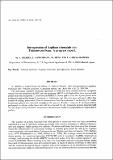Por favor, use este identificador para citar o enlazar a este item:
http://hdl.handle.net/10261/13115COMPARTIR / EXPORTAR:
 SHARE
BASE SHARE
BASE
|
|
| Visualizar otros formatos: MARC | Dublin Core | RDF | ORE | MODS | METS | DIDL | DATACITE | |

| Campo DC | Valor | Lengua/Idioma |
|---|---|---|
| dc.contributor.author | Delibes, A. | - |
| dc.contributor.author | López-Braña, I. | - |
| dc.contributor.author | Mena, M. | - |
| dc.contributor.author | García-Olmedo, Francisco | - |
| dc.date.issued | 1988 | - |
| dc.identifier.citation | An. estac. Exp. Aula Dei, v. 19 (1988), n. 1/2: 189-194. | en_US |
| dc.identifier.issn | 0365-1800 | - |
| dc.identifier.uri | http://hdl.handle.net/10261/13115 | - |
| dc.description.abstract | [EN] The wild grass Aegilops triuncialis (genomes CCUU) has been crossed with the tetraploid wheat Triticum turgidum (AABB) and the resulting ABCU sterile hybrid has been rescued with pollen from the hexaploid T. aestivum (AABBDD). Seven spikes from two hybrid plants were pollinated with pollen from T. aestivum cv. Almatense and 8 kernels were obtained. After five rounds of selfing, plants with 28 to 41 chromosomes have been derived. Low fertility (3-5 viable kernels per plant) was observed throughout the process. Further crosses to T. aestivum will be performed to obtain stable lines that will be screened for Ae. triuncialis genetic material with the aid of previously identified biochemical chromosome markers and specially developed DNA probes. [ES] Varias proteínas de endospermo pertenecientes a una familia de inhibidores de @-amilasas heterologas y de tripsina han sido purificadas y caracterizadas en trigo, cebada y centeno. La comparación de sus secuencias de aminoácidos y la localización cromosómica de sus genes estructurales indican que estos inhibidores están codificados por una familia multigénica dispersa que debió originarse por traslocaciones y duplicaciones intracromosómicas en una especie ancestral de trigo, cebada y centeno. La homología entre algunos miembros de esta familia de inhibidores y varias proteínas de maíz, ricino, mijo indio, etc., indica que la familia se extiende a otras especies flogenéticamente distantes de los tres cereales antes mencionados. | en_US |
| dc.language.iso | eng | en_US |
| dc.publisher | CSIC - Estación Experimental de Aula Dei (EEAD) | en_US |
| dc.rights | openAccess | en_US |
| dc.subject | Triticum aestivum | en_US |
| dc.subject | Aegilops triuncialis | en_US |
| dc.subject | Introgression | en_US |
| dc.subject | Gene transfer | en_US |
| dc.title | Introgression of Aegilops triuncialis into Triticum aestivum. A progress report. | en_US |
| dc.type | artículo | en_US |
| dc.description.peerreviewed | Peer reviewed | en_US |
| dc.type.coar | http://purl.org/coar/resource_type/c_6501 | es_ES |
| item.openairetype | artículo | - |
| item.grantfulltext | open | - |
| item.cerifentitytype | Publications | - |
| item.openairecristype | http://purl.org/coar/resource_type/c_18cf | - |
| item.fulltext | With Fulltext | - |
| item.languageiso639-1 | en | - |
| Aparece en las colecciones: | (EEAD) Artículos | |
Ficheros en este ítem:
| Fichero | Descripción | Tamaño | Formato | |
|---|---|---|---|---|
| ANALES_19_1-2-Introgression of Aegilops.pdf | 352,37 kB | Adobe PDF |  Visualizar/Abrir |
CORE Recommender
Page view(s)
290
checked on 18-abr-2024
Download(s)
348
checked on 18-abr-2024
Google ScholarTM
Check
NOTA: Los ítems de Digital.CSIC están protegidos por copyright, con todos los derechos reservados, a menos que se indique lo contrario.
